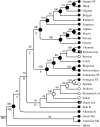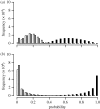Your place or mine? A phylogenetic comparative analysis of marital residence in Indo-European and Austronesian societies
- PMID: 21041215
- PMCID: PMC2981910
- DOI: 10.1098/rstb.2010.0017
Your place or mine? A phylogenetic comparative analysis of marital residence in Indo-European and Austronesian societies
Abstract
Accurate reconstruction of prehistoric social organization is important if we are to put together satisfactory multidisciplinary scenarios about, for example, the dispersal of human groups. Such considerations apply in the case of Indo-European and Austronesian, two large-scale language families that are thought to represent Neolithic expansions. Ancestral kinship patterns have mostly been inferred through reconstruction of kin terminologies in ancestral proto-languages using the linguistic comparative method, and through geographical or distributional arguments based on the comparative patterns of kin terms and ethnographic kinship 'facts'. While these approaches are detailed and valuable, the processes through which conclusions have been drawn from the data fail to provide explicit criteria for systematic testing of alternative hypotheses. Here, we use language trees derived using phylogenetic tree-building techniques on Indo-European and Austronesian vocabulary data. With these trees, ethnographic data and Bayesian phylogenetic comparative methods, we statistically reconstruct past marital residence and infer rates of cultural change between different residence forms, showing Proto-Indo-European to be virilocal and Proto-Malayo-Polynesian uxorilocal. The instability of uxorilocality and the rare loss of virilocality once gained emerge as common features of both families.
Figures




Similar articles
-
Reconstructing the history of residence strategies in Indo-European-speaking societies: neo-, uxori-, and virilocality.Hum Biol. 2011 Feb;83(1):107-28. doi: 10.3378/027.083.0107. Hum Biol. 2011. PMID: 21453007
-
Evolution of initiation rites during the Austronesian dispersal.Sci Prog. 2021 Jul-Sep;104(3):368504211031364. doi: 10.1177/00368504211031364. Sci Prog. 2021. PMID: 34236926 Free PMC article.
-
Reconstructing the history of marriage strategies in Indo-European-speaking societies: monogamy and polygyny.Hum Biol. 2011 Feb;83(1):87-105. doi: 10.3378/027.083.0106. Hum Biol. 2011. PMID: 21453006
-
Matrilocal residence is ancestral in Austronesian societies.Proc Biol Sci. 2009 Jun 7;276(1664):1957-64. doi: 10.1098/rspb.2009.0088. Epub 2009 Mar 4. Proc Biol Sci. 2009. PMID: 19324748 Free PMC article.
-
Language evolution and human history: what a difference a date makes.Philos Trans R Soc Lond B Biol Sci. 2011 Apr 12;366(1567):1090-100. doi: 10.1098/rstb.2010.0378. Philos Trans R Soc Lond B Biol Sci. 2011. PMID: 21357231 Free PMC article. Review.
Cited by
-
Cultural phylogenetics of the Tupi language family in lowland South America.PLoS One. 2012;7(4):e35025. doi: 10.1371/journal.pone.0035025. Epub 2012 Apr 10. PLoS One. 2012. PMID: 22506065 Free PMC article.
-
Comparative phylogenetic analyses uncover the ancient roots of Indo-European folktales.R Soc Open Sci. 2016 Jan 20;3(1):150645. doi: 10.1098/rsos.150645. eCollection 2016 Jan. R Soc Open Sci. 2016. PMID: 26909191 Free PMC article.
-
Community differentiation and kinship among Europe's first farmers.Proc Natl Acad Sci U S A. 2012 Jun 12;109(24):9326-30. doi: 10.1073/pnas.1113710109. Epub 2012 May 29. Proc Natl Acad Sci U S A. 2012. PMID: 22645332 Free PMC article.
-
Cultural macroevolution on neighbor graphs : vertical and horizontal transmission among Western North American Indian societies.Hum Nat. 2012 Sep;23(3):283-305. doi: 10.1007/s12110-012-9142-z. Hum Nat. 2012. PMID: 22791406
-
Pama-Nyungan grandparent systems change with grandchildren, but not cross-cousin terms or social norms.Evol Hum Sci. 2020 Jun 5;2:e30. doi: 10.1017/ehs.2020.31. eCollection 2020. Evol Hum Sci. 2020. PMID: 35663513 Free PMC article.
References
-
- Anthony D. W.2007The horse, the wheel, and language: how Bronze-Age riders from the Eurasian steppes shaped the modern world. Princeton, NJ: Princeton University Press
-
- Bentley R. A., Price T. D., Lüning J., Gronenborn D., Wahl J., Fullagar P. D.2002Prehistoric migration in Europe: strontium isotope analysis of Early Neolithic skeletons. Curr. Anthropol. 43, 799–804 (doi:10.1086/344373) - DOI
-
- Blust R.1980Early Austronesian social organization—the evidence of language. Curr. Anthropol. 21, 205–247 (doi:10.1086/202430) - DOI
-
- Boyd R., Richerson P. J., Borgerhoff-Mulder M., Durham W. H.1997Are cultural phylogenies possible? In Human by nature: between biology and the social sciences (eds Weingart P., Richerson P. J., Mitchell S. D., Maasen S.), pp. 355–386 Mahwah, NJ: Lawrence Erlbaum Associates
-
- Borgerhoff Mulder M., Nunn C. L., Towner M. C.2006Cultural macroevolution and the transmission of traits. Evol. Anthropol. 15, 52–64 (doi:10.1002/evan.20088) - DOI
Publication types
MeSH terms
LinkOut - more resources
Full Text Sources
Research Materials
Miscellaneous

